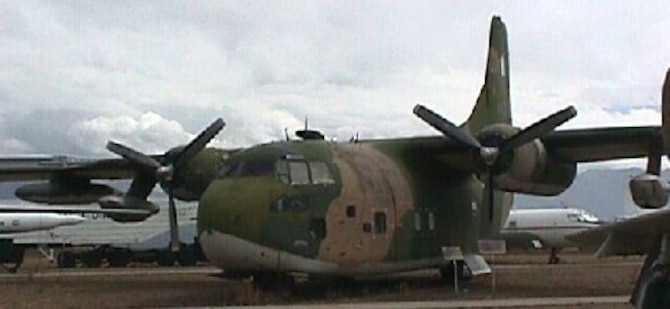Fairchild-Chase C-123K “Provider”
S/N 54-610
Crew: Two to four
Engines: Two Pratt & Whitney R-2800 radials (2,500 hp each);
two auxiliary General Electric J85 turbojets (2,850 lbs thrust each)
Wingspan: 110 ft 0 in
Length: 76 ft 3 in
Height: 34 ft 6 in
Weight: max: 60,000 lbs
Speed: max: 240 mph; cruise: 170 mph
Range: 1,825 miles
Service Ceiling: 28,000 ft
Armament: None
Cost: $601,719
Chase Airlift produced the C-123K in 1949 as a heavy assault glider. The engines were later added to the aircraft. After Chase could not deliver the aircraft, so the United States Air Force awarded the contract to Fairchild in 1954. The aircraft featured high-mounted winds and tail surfaces on a pod-type fuselage which made for easier rear end, unobstructed on and off loading. The powerful engines showed superior ability to operate in short field landings and take offs.
The aircraft could carry 61 fully equipped troops for assault or evacuate 50 patients on litters plus six attendants. Several aircraft were converted to AC-123K gunships with multi-sensors for counter insurgency efforts, attacking ground forces with a 7.62mm mini gun. In 1966, some models, including the aircraft at the Hill Aerospace Museum, were fitted with auxiliary power plants in a pylon-mounted 2,850 lbs. thrust GE J85 turbojet outboard of each engine. These were only for emergency use.
Other operators, besides the United States Air Force, and United States Coast Guard, of this aircraft were Cambodia, Saudi Arabia, South Korea, Thailand and Venezuela. Production of the C-123K stopped in September 1969.
The Ogden Air Logistics Center at Hill Air Force Base has prime supply, maintenance, and specalized depot responsibilities for the C-123 starting in 1972. The C-123s were used at Hill for aerial spraying duties on the Utah Test and Training Range in the desert.
Our C-123K was originally manufactured as a C-123B-6-FA by the Fairchild Corporation in Maryland and delivered to the United States Air Force in December 1955 when it was immediately assigned to the 309th Troop Carrier Group, Tactical Air Command at Ardmore Air Force Base. In May 1956 the aircraft was transferred to the 60th Troop Carrier Wing, Medium, USAF Europe at Dreux AB in France. It then was moved to the 2584th Air Reserve Flying Center, Air Force Reserve, at the municipal airport in Memphis in July 1958.
In November of 1959, the aircraft flew to Middletown Air Material Area, returning the following month to Memphis, this time with the 445th Troop Carrier Wing, Assault, Air Force Reserve. It was temporary transferred in February 1963 to the 920th Material Squadron at the Memphis airport. The following month it was returned to the 445th TCW. Later that year, the aircraft went to the 920th Troop Carrier Group, Assault, AFRES at the same field. In October 1965 the aircraft was moved to the 401st Tactical Fighter Wing, Tactical Air Command at England Air Force Base in Louisiana, then was moved that December to the 1st Air Commando Wing at the same base.
In April 1966 the aircraft was sent back to the Fairchild factory to be upgraded to a C-123K, receiving two General Electric J85 engine pods. In February 1967 the aircraft was transferred to the 4410th Combat Crew Training Wing (TAC) at Eglin Air Force Base in Florida. The C-123K was then moved in July 1969 to the 1st Special Operation wing at Eglin before moving to the 317th Tactical Airlift Wing at Lockbourne Air Force Base that fall.
In August 1971, the aircraft was transferred to the 4410th Special Operations Training Group at England Air Force Base. It was then moved to the 911th Tactical Airlift Group in Pittsburgh in April 1972. From there it was transferred to the 731st Tactical Airlift Squadron at Westover Air Force Base in June 1980.
The aircraft was retired in August of 1982 to MASDC at Davis-Monthan and was eventually acquired by T.B.M. Inc. of Tulare California, a company that specializes in air tanker services, aerial fighting, and aircraft maintenance. While with this company, the aircraft appeared in the James Bond movie “The Living Daylights” and the movie “Tucker.” It was also used in a few television series during this period.
The aircraft was traded to the Forest Service of the United States Department of Agriculture in exchange for a C-130. The place was then assigned to the Hill Aerospace Museum in May 1989 for static display. It became a part of the Air Force Museum System in 2008 and is on load to the Aerospace Museum from the National Museum of the United States Air Force.

